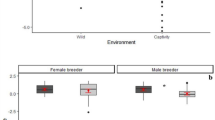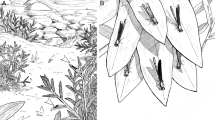Seeing off a neighbour's intruder may be easier than negotiating with a larger usurper.
Abstract
Until now, no compelling evidence has emerged from studies of animal territoriality to indicate that a resident will strategically help a neighbour to defend its territory against an intruder1,2. We show here that territory-owning Australian fiddler crabs will judiciously assist other crabs in defending their neighbouring territories. This cooperation supports the prediction3 that it is sometimes less costly to assist a familiar neighbour than to renegotiate boundaries with a new, and possibly stronger, neighbour4.
Similar content being viewed by others
Main
In Darwin, Australia, the sexually dimorphic fiddler crab Uca mjoebergi lives in mixed-sex colonies on intertidal mudflats. Males have one greatly enlarged claw (Fig. 1), which is used both for attracting females and as a weapon5,6. Each crab defends an all-purpose territory containing a central burrow that is used as a refuge during high tide. Males mainly fight other males and vigorously defend their territory against wandering ‘floaters’ that are seeking a new burrow. They also repel neighbours that encroach on their territory.
Fights involving three males have been recorded, but the territorial status of the participants was unknown5. We therefore tracked 268 floaters until we saw them fighting a territorial male. We recorded 17 cases in which a resident that was fighting an intruding floater was joined by an immediate neighbour (henceforth called an ‘ally’). These fights always occurred at the resident's burrow entrance so the ally had to vacate his own territory temporarily to join the fight. The two neighbours never fought each other. They pushed or grappled only with the intruder.
Allies helped when they were most likely to have a beneficial effect. In unassisted fights, the smaller the resident was compared with the floater, the greater was the likelihood that he would be evicted (logistic regression, χ21 = 36.4, P<0.001, n = 251). In 94% of cases when assistance was provided, the resident was smaller than the intruding floater, but this was only true in 51% of cases when no assistance was given (Fisher's exact test, P = 0.001, 16/17 compared with 128/251). Males therefore provided assistance when their neighbour was more likely to lose his territory.
In addition, the ally was generally larger than the floater (binomial test, P = 0.013, 14/17; mean ± s.d. for claw length, 21.0 ± 2.9 mm compared with 18.5 ± 4.0 mm) and therefore more likely than his smaller neighbour (14.8 ± 4.0 mm) to defeat the floater. The ally was always larger than the assisted neighbour (binomial test, P<0.0001, 17/17). The net result was that assisted residents were evicted during the contests significantly less often than unassisted residents (logistic regression, χ21 = 9.6, P = 0.002, n = 268, 12% compared with 29%).
Helping is potentially costly. Allies leave their territory, which increases the risk that their own burrow will be usurped7, and fighting is energetically expensive and can result in claw loss5,6. So why do territory owners help neighbours? First, we can exclude direct reciprocal altruism8 because allies were always larger than the males they assisted. Second, there is no evidence that floaters pose a delayed threat to allies. When we continued to track a floater after his first fight, we never saw him fight his previous opponent's neighbour; floaters moved 73.7 ± 34.9 cm between successive fights, compared with a mean distance between neighbours of ± 10 cm (n = 30 floaters).
It has been predicted that residents will form territorial coalitions when losing neighbours is costly3. To test this, we located 20 large males with a smaller neighbour (size-matched to observed helper–resident pairs) and watched them for 15 minutes. In no case did we observe threat displays or fights between neighbours. To mimic neighbour eviction or retention, we then either replaced the smaller neighbour with an intermediate-sized male (n = 10), or caught the smaller neighbour and then returned him to his territory (n = 10). Once both territory owners were present on the surface, we watched them for another 15 minutes. We observed no threat displays or fights when the smaller neighbour stayed. After replacement, however, the larger male approached and fought the unfamiliar neighbour in nine out of ten cases (Fisher's exact test, P<0.001).
Territorial coalitions in U. mjoebergi seem to be due to by-product mutualism9: the ally pays to retain an established neighbour and the neighbour keeps his territory. The circumstances under which assistance was provided appeared to involve judicious decision-making. That this occurs in an invertebrate, but has still not been reported in birds or mammals, suggests that territorial coalitions depend more on appropriate circumstances than on advanced cognitive skills.
References
Morrell, L. J. & Kokko, H. Behav. Ecol. Sociobiol. 54, 385–395 (2003).
Elfström, S. T. Anim. Behav. 54, 535–542 (1997).
Getty, T. Am. Zool. 27, 327–336 (1987).
Stamps, J. A. & Krishnan, V. V. Am. Nat. 157, 154–169 (2001).
Crane, J. A. Fiddler Crabs of the World (Princeton Univ. Press, Princeton, New Jersey, 1976).
Backwell, P. R. Y., Christy, J. H., Telford, S. R., Jennions, M. D. & Passmore, N. I. Proc. R. Soc. Lond. B 267, 719–724 (2000).
Hemmi, J. M. & Zeil, J. Nature 421, 160–163 (2003).
Trivers, R. L. Q. Rev. Biol. 46, 35–57 (1971).
Dugatkin, L. A. Cooperation Among Animals (Oxford Univ. Press, New York, 1997).
Author information
Authors and Affiliations
Corresponding author
Ethics declarations
Competing interests
The authors declare no competing financial interests.
Rights and permissions
About this article
Cite this article
Backwell, P., Jennions, M. Coalition among male fiddler crabs. Nature 430, 417 (2004). https://doi.org/10.1038/430417a
Published:
Issue Date:
DOI: https://doi.org/10.1038/430417a
This article is cited by
-
Social behaviors elevate predation risk in fiddler crabs: quantitative evidence from field observations
Behavioral Ecology and Sociobiology (2022)
-
The importance of strength and stamina varies with ownership status in sand fiddler crab contests for breeding burrows
Behavioral Ecology and Sociobiology (2019)
-
Aggression towards shared enemies by heterospecific and conspecific cichlid fish neighbours
Oecologia (2019)
-
Allopatry, competitor recognition and heterospecific aggression in crater lake cichlids
BMC Evolutionary Biology (2016)
-
On the Evolution of Partial Respect for Ownership
Dynamic Games and Applications (2016)
Comments
By submitting a comment you agree to abide by our Terms and Community Guidelines. If you find something abusive or that does not comply with our terms or guidelines please flag it as inappropriate.




